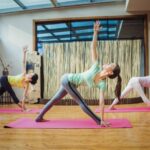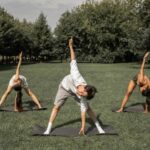Flexibility exercises, which constitute an integral part of a holistic fitness regimen, are designed to enhance the range of motion in joints and improve muscle elasticity. Engaging regularly in activities that stretch and elongate the muscles not only serves to prevent injuries but also aids in reducing back pain and issues with balance. By promoting a greater range of motion, individuals can perform daily tasks with more ease and are less likely to experience discomfort or injury due to sudden movements.
The importance of flexibility cannot be overstated when considering overall health and wellness. It supports the body’s ability to move freely and respond to physical demands without excess strain. Furthermore, exercises aimed at increasing flexibility contribute to efficient blood circulation, ensuring that tissues receive a steady supply of oxygen and nutrients. This improved circulatory efficiency can lead to faster recovery times after exercising and reduced soreness.
In addition to physical health benefits, flexibility exercises can foster a positive state of mind. The process of stretching and mindful breathing often leads to a sense of relaxation and mental calmness, as it can help to release tension held in the body. This mental relief is just as crucial as the physical advantages, as it can impact overall well-being and quality of life.
The Science of Flexibility
Flexibility is a cornerstone of physical fitness, involving the elasticity of muscles and the capacity of joints to move through a full range of motion. It is influenced by various physiological factors and changes with age.
Understanding Range of Motion
Range of motion (ROM) refers to the extent to which joints can move in various directions without causing discomfort. It is a crucial component for performing daily tasks as well as athletic activities. Flexibility exercises target the muscles and joint structures, enhancing pliability and potentially reducing resistance to movement. For instance, muscle fascia, a type of connective tissue, makes up a significant portion of a muscle’s mass and can contribute to over 40% of muscle resistance to movement.
Aspects impacting ROM include:
- Muscle elasticity: The ability of muscle fibers to stretch and return to their original length.
- Joint structure: The type of joint and the congruity of the surfaces involved, which dictate the joint’s potential movement.
Age-Related Flexibility Changes
Flexibility tends to decline with aging, as changes in muscles and joints occur. This can lead to an increased risk of injuries and decreased functional capabilities. In an older adult, muscles may lose mass, and connective tissues can become less hydrated, leading to a stiffer and more restricted range of motion.
Key age-related changes in flexibility:
- Muscles: Decrease in muscle mass and elasticity.
- Joints: Reduction in synovial fluid production, which can affect joint lubrication.
In summary, the science behind flexibility is multifaceted, encompassing the mechanics of muscles and joints, and is subject to alterations over the lifespan due to physiological transformations.
Benefits of Flexibility Training
Flexibility training is an integral component of an overall fitness regimen, vital for enhancing muscle function and joint health. It helps to optimize physical performance while mitigating the risk of injuries.
Injury Prevention
Flexibility exercises are key in preventing injuries. They allow muscles to work most effectively by extending their range of motion (ROM). When muscles can move freely, the likelihood of strains or muscle imbalances decreases. Flexibility training also keeps the connective tissue, such as tendons and ligaments, more pliable which reduces the risk of tears.
Pain Reduction
Stretching and flexibility exercises tend to alleviate pain, especially in the back and joints, by reducing muscle tension and improving circulation. Enhanced blood flow ensures that muscles receive an adequate supply of nutrients and oxygen, helping to manage soreness and reduce muscle stiffness.
Improved Performance and Balance
Individuals who practice flexibility training typically see an improvement in performance due to greater freedom of movement. This can translate to more efficient and unrestricted movements during exercise and daily tasks. Additionally, flexibility training contributes to better balance and coordination, which helps maintain correct posture and reduces the likelihood of falls.
Developing a Flexibility Routine
A flexibility routine should be tailored to individual needs, incorporating a balance between dynamic and static stretching. Allocating time for warm-up and cool-down is crucial for maximizing the benefits and safety of flexibility exercises.
Creating Your Personal Stretching Program
When one develops a personal stretching program, it should be aligned with their specific goals and daily activities. They should aim for at least 3 days a week of flexibility training, with each session lasting about 10 to 15 minutes. The program must be progressive, starting with simpler stretches and gradually moving to more complex patterns as flexibility improves.
- Frequency: Begin with 3 sessions per week.
- Duration: Each session should be 10-15 minutes.
- Progression: Start with basic stretches, advancing over time.
Incorporating Dynamic and Static Stretching
Dynamic stretching should be included at the start of the stretching routine to prepare the muscles for physical activity. These are controlled movements that improve range of motion and prime the muscles for more intense stretching. Examples include leg swings and arm circles. Following these, one should transition into static stretching, where stretches are held for a period to increase muscle length and flexibility. Examples are touching the toes or holding a quad stretch.
- Dynamic Stretch Examples: Leg swings, arm circles.
- Static Stretch Examples: Toe touch, quad hold.
- Transition: Start with dynamic, end with static.
The Role of Warm-Up and Cool-Down
A warm-up should precede any stretching routine to raise body temperature and reduce the risk of injury. It might include light jogging or cycling for 5 to 10 minutes. The warm-up sets the stage for more effective dynamic stretching. After completing the stretching exercises, a cool-down helps to gradually reduce the heart rate and settle the muscles, which might involve walking or gentle static stretches. Including a cool-down can aid in recovery and prepare the muscles for rest.
- Warm-Up: 5-10 minutes of light jogging or cycling.
- Cool-Down: Gentle static stretches or walking to settle the muscles.
Key Flexibility Exercises
Flexibility exercises are essential in improving joint range of motion and muscle elasticity. They are instrumental in decreasing the risk of injury and enhancing athletic performance. Below are key exercises divided into categories, each targeting various muscle groups and utilizing different methods to promote flexibility.
Yoga and Pilates for Flexibility
Yoga and Pilates are two disciplines renowned for their emphasis on flexibility and controlled movements. Yoga incorporates poses like the Downward Dog and Cat-Cow, which stretch the spine, hamstrings, and arms. Pilates, with exercises such as the Pilates Hundred, works on core strength along with flexibility, emphasizing controlled movements to lengthen the major muscle groups.
Targeted Stretches for Major Muscle Groups
- Hamstrings: To stretch the hamstrings, one effective exercise is the Standing Hamstring Stretch where an individual bends forward from the hips towards their toes while keeping their knees straight.
- Arms: Triceps Stretches, where one hand is brought down the back with the other hand pushing gently on the elbow, and Wrist Extension Stretches are fundamental for the upper extremities.
A consistent routine that includes static stretches—holding a stretch for 10-30 seconds—and dynamic stretches, like leg swings and lunges, can significantly improve flexibility in these major muscle groups.
Using Props and Tools
Props such as foam rollers and stretching straps can further enhance a flexibility routine.
- Foam Rolling: This self-myofascial release technique can help alleviate muscle tightness by rolling out muscles like the calves and thighs.
- Stretching Straps: They are particularly useful for individuals with limited flexibility to achieve and maintain stretches such as those for the legs and back.
By incorporating these props, individuals can effectively deepen their stretches and ensure proper alignment and support during flexibility exercises.
Incorporating Flexibility into Everyday Life
Incorporating flexibility exercises into one’s routine is vital for performing daily activities efficiently and preventing strain or injury. These exercises are particularly beneficial as they can be done anywhere, from the office to the comfort of one’s home, and they play a crucial role in combating the effects of aging on the body’s range of motion.
Exercises for the Office and Home
At the office, individuals can integrate flexibility exercises into their day with minimal disruption. For example:
- Desk stretches: Every hour, workers should perform seated twists and arm reaches to maintain upper body flexibility.
- Leg extensions: While sitting, one can extend each leg and hold it for a few seconds to strengthen the thigh muscles and promote blood flow.
At home, flexibility routines can include:
- Yoga routines: A 15-minute yoga session in the morning or evening to enhance flexibility and relax the mind.
- Dynamic stretches: Lunges and arm circles that can be done while performing tasks such as watching TV or cooking.
Incorporating these simple exercises regularly can help individuals maintain flexibility and prevent the tightness that often accompanies prolonged sitting and static postures.
Maintaining Flexibility While Aging
As one ages, maintaining flexibility becomes increasingly important to ensure that daily activities can be performed without discomfort. Older adults should focus on:
- Consistent stretch routines: Engaging in gentle daily stretching to preserve joint range of motion and muscle elasticity.
- Balanced activity: Combining stretching with balance exercises like standing on one foot, which can reduce the risk of falls.
An emphasis on flexibility helps older individuals maintain independence and quality of life, along with reducing the potential for injuries and falls.
Flexibility for Athletic Performance
Incorporating flexibility exercises into a training regimen is vital for enhancing athletic performance and preventing injuries. Flexibility training serves as a foundation for athletes in all disciplines, from sprinting to strength training.
Training for Sports and Active Lifestyles
Athletes who integrate flexibility exercises exhibit improved performance due to the enhancement of their dynamic movements. A dynamic warmup that includes flexibility components, such as walking lunges, prepares the body for the complex movements of sports. This type of warmup can increase blood flow, raise muscle temperature, and improve the range of motion, which collectively contribute to more efficient and injury-free athletic performance.
- Key Benefits for Athletic Performance:
- Increases muscular coordination
- Enhances time needed for explosive movements
- Helps maintain optimal muscle length and balance
For example, sprinters benefit from having flexible hamstrings which allow them a fuller range of motion and a consequent increase in stride length. Furthermore, studies have shown that athletes engaging in flexibility training can see improvements in sprinting performance and overall athletic ability.
Preventing Sports-Related Injuries
Athletes who include flexibility exercises in their routine reduce their risk of sports-related injuries. By enabling muscles to work most effectively, flexibility training can decrease the occurrence of muscle imbalances—a common issue for those who focus heavily on strength training without sufficient stretching.
- Injury Prevention Benefits:
- Promotes proper muscle alignment
- Reduces muscle stiffness and soreness
- Decreases the likelihood of strains and sprains
Regular flexibility exercises ensure that athletes not only perform at their best but also maintain a lower risk for injuries that can set back training and competition. This approach is equally beneficial in sports requiring a wide range of motion and in daily activities that contribute to an athlete’s active lifestyle.
Professional Guidance and Physical Therapy
When incorporating flexibility exercises into one’s routine, working with a professional can maximize benefits and minimize risks. Physical therapists and trained personal trainers can provide personalized guidance, especially for those with chronic conditions or back pain.
When to Consult a Physical Therapist
One should consider consulting a physical therapist if:
- Physical Activity Causes Pain: Physical activity should not lead to pain. If one experiences discomfort or sharp pain during exercises, a therapist can identify the underlying issues.
- Chronic Conditions: Individuals with chronic conditions may require specialized exercise plans. For instance, those with arthritis may need particular attention to prevent joint strain.
- Recovery from Injury: After injuries, especially those related to muscles and joints, a physical therapist can help ensure a safe return to activity.
- Back Pain: Persistent or severe back pain is a sign to seek professional advice. A therapist can facilitate exercises that build core strength and improve posture, reducing the risk of further injury.
Tailoring Flexibility Training to Individual Needs
A physical therapist or a qualified personal trainer is instrumental in:
- Assessing Individual Needs: They conduct comprehensive assessments to understand one’s flexibility, resistance levels, and overall physical condition.
- Developing a Personalized Plan: Based on the assessment, they develop a tailored training plan that reflects personal goals and physical capabilities.
- Teaching Proper Techniques: They ensure one is performing exercises correctly, which is crucial for effectiveness and safety.
- Adjusting Resistance and Intensity: Proper adjustment of resistance and intensity in flexibility exercises prevents overstretching and injury while promoting optimal flexibility gains.
Addressing Common Concerns and Misconceptions
This segment addresses prevalent myths around flexibility and stretching, and provides guidance for managing health conditions related to flexibility.
Myths About Flexibility and Stretching
Myth: Flexibility is Inherent and Unchangeable
Contrary to popular belief, flexibility is not solely determined by genetics; it can be improved with consistent stretching exercises. Muscle tightness and joint pain need not be permanent conditions.
Myth: Stretching Is Only Necessary for Athletes
Regular flexibility exercises benefit everyone, not just athletes. They alleviate muscle soreness, increase blood flow to connective tissues, and can reduce discomfort from cold muscles.
Myth: Stretching Should Always Be Done Before Exercise
There is no one-size-fits-all approach to stretching. While dynamic stretches may be beneficial before exercise to warm up cold muscles, static stretches are often more effective post-exercise to alleviate muscle soreness.
Understanding and Managing Health Conditions
Health Concerns Involving Flexibility
Flexibility exercises are not just about achieving greater range of motion; they are a vital component in managing and mitigating various health concerns. For those experiencing joint pain, a well-curated stretching routine can mean the difference between discomfort and relief.
Role of Flexibility in Daily Life
Adequate flexibility and the health of connective tissues play a significant role in daily functions, such as maintaining balance and posture. Regularly engaging in flexibility exercises can help individuals combat the rigidity that comes with aging, thereby enhancing overall life quality.
In each subsection, clear and accurate information dispels widespread misconceptions and illustrates the considerable importance of flexibility and stretching in the context of health and daily living.








